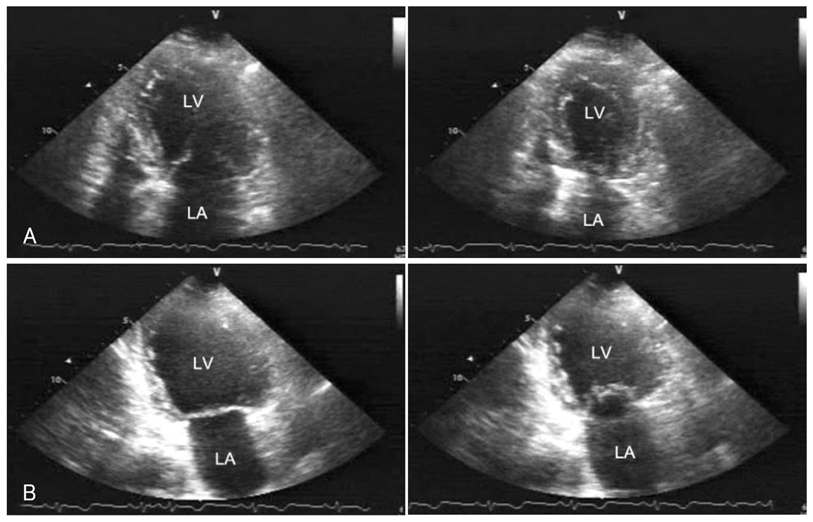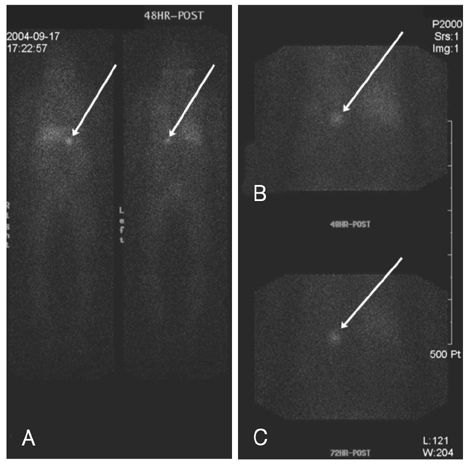Korean Circ J.
2009 Jun;39(6):254-257. 10.4070/kcj.2009.39.6.254.
Recurrent Catecholamine-Induced Cardiomyopathy in a Patient With a Pheochromocytoma
- Affiliations
-
- 1Division of Cardiology, Department of Internal Medicine, Kyungpook National University Medical School, Daegu, Korea. ddhyang@knu.ac.kr
- KMID: 1490702
- DOI: http://doi.org/10.4070/kcj.2009.39.6.254
Abstract
- Pheochromocytomas presents with variable clinical manifestations. Cardiomyopathy caused by a pheochromocytoma is well known. We report the case of a 62-year-old woman with recurrent left ventricular dysfunction, who was subsequently found to have a pheochromocytoma. The patient had two different patterns of cardiomyopathy. Patients with a cardiomyopathy, of non-specific origin, should have a pheochromocytoma ruled out.
Keyword
MeSH Terms
Figure
Reference
-
1. Mann DL, Kent RL, Parsons B, Cooper G 4th. Adrenergic effects on the biology of the adult mammalian cardiocyte. Circulation. 1992. 85:790–804.2. Szakacs JE, Cannon A. L-Norepinephrine myocarditis. Am J Clin Pathol. 1958. 30:425–434.3. Sardesai SH, Mourant AJ, Sivathandon Y, Farrow R, Gibbons DO. Phaeochromocytoma and catecholamine induced cardiomyopathy presenting as heart failure. Br Heart J. 1990. 63:234–237.4. Attar MN, Moulik PK, Salem GD, Rose EL, Khaleeli AA. Phaeochromocytoma presenting as dilated cardiomyopathy. Int J Clin Pract. 2003. 57:547–548.5. Hong SK, Choi H, Lee SC. Reversal of dilated cardiomyopathy with medical therapy in a case of pheochromocytoma. Korean Circ J. 1998. 28:284–290.6. Takizawa M, Kobayakawa N, Uozumi H, et al. A case of transient left ventricular ballooning with pheochromocytoma, supporting pathogenetic role of catecholamines in stress-induced cardiomyopathy or takotsubo cardiomyopathy. Int J Cardiol. 2007. 114:e15–e17.7. Takeno Y, Eno S, Hondo T, Matsuda K, Zushi N. Pheochromocytoma with reversal of tako-tsubo-like transient left ventricular dysfunction: a case report. J Cardiol. 2004. 43:281–287.8. Sanchez-Recalde A, Costero O, Oliver JM, Iborra C, Ruiz E, Sobrino JA. Images in cardiovascular medicine: pheochromocytoma-related cardiomyopathy: inverted Takotsubo contractile pattern. Circulation. 2006. 113:e738–e739.9. van de Walle SO, Gevaert SA, Gheeraert PJ, De Pauw M, Gillebert TC. Transient stress-induced cardiomyopathy with an "inverted takotsubo" contractile pattern. Mayo Clin Proc. 2006. 81:1499–1502.10. Copetti R, Gonano C, Colombo T, Cattarossi L. "Inverted Takotsubo" pattern. Resuscitation. 2007. 74:394.
- Full Text Links
- Actions
-
Cited
- CITED
-
- Close
- Share
- Similar articles
-
- Catastrophic catecholamine-induced cardiomyopathy rescued by extracorporeal membrane oxygenation in recurrent malignant pheochromocytoma
- A case of pheochromocytoma with acute pancreatitis and catecholamine-induced cardiomyopathy
- Anesthetic experience of pheochromocytoma resection with catecholamine-induced cardiomyopathy and congestive heart failure : A case report
- A Case of Normalized Hypertrophic Cardiomyopathy after Removal of Pheochromocytoma
- A Case of Reversible Catecholamine Induced Cardiomyopathy by Retrobulbar Epinephrine Injection





